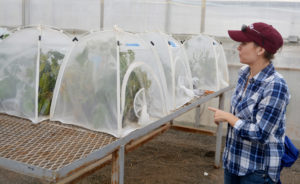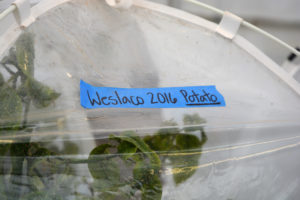Farm & Ranch
Neonicotinoid insecticides losing efficiency in potato psyllid control

By: Kay Ledbetter
AgriLife Research study shows biological control may help
Writer: Kay Ledbetter, 806-677-5608, [email protected]
Contact: Dr. Ada Szczepaniec, 806-354-5806, [email protected]
AMARILLO – The potato industry may be losing a mainstay in the battle against psyllids, according to a recent Texas A&M AgriLife Research study.

Dr. Ada Szczepaniec discusses her greenhouse study on potato psyllid resistance to neonicotinoid insecticides. (Texas A&M AgriLife photo by Kay Ledbetter)
Dr. Ada Szczepaniec, AgriLife Research entomologist in Amarillo, said while there may be varying degrees of resistance to neonicotinoid insecticides in populations of psyllids across Texas, her recent study indicates they’ve lost their punch.
“We are able to provide strong evidence that these insecticides no longer suppress populations of psyllids below desirable levels,” Szczepaniec said. “However, there may be some biological control measures to help in this ongoing battle against the potato psyllid.”
The potato psyllid is a tiny insect with sucking, piercing mouthparts that transmits a bacterium, Candidatus Liberibacter solanacearum or Lso, which causes a disease called zebra chip and can cause tremendous losses to producers, she said. Producers have used the neonicotinoid insecticides to protect their solanaceous crops, mostly potatoes, in the past.
Szczepaniec said the study, funded by the Texas Department of Agriculture, indicates applications of neonicotinoid insecticides at planting, which are a considerable cost for producers, should be replaced with investments in post-emergence applications of insecticides other than neonicotinoids.
Integrating predators in suppression of psyllids could also be considered, especially when incidence of Lso is low and the threat of zebra chip disease is decreased, she said. However, more research is needed before recommendations regarding biological control can be made.
Her study included colonies of the potato psyllid from all major potato-producing areas of Texas. These colonies were established and maintained in the greenhouse for at least two generations before experiments examining their resistance to neonicotinoid insecticides began.
“Over the course of a year and a half, we completed testing the majority of the populations of psyllids for resistance to imidacloprid and thiamethoxam,” Szczepaniec said.

Colonies of the potato psyllid from all major potato-producing areas of Texas were studied. (Texas A&M AgriLife photo by Kay Ledbetter)
Based on the Insecticide Resistance Action Committee definition of resistance, “heritable change in the sensitivity of a pest population that is reflected in the repeated failure of a product to achieve expected level of control,” the potato psyllid populations across Texas are resistant to both neonicotinoid insecticides, she said.
Szczepaniec conducted a second study to identify alternative biological controls. Surveys of all arthropods associated with three different potato types – a russet, a red and a chipping variety – were carried out at the AgriLife Research station near Bushland.
“While we have only one year of data to draw our conclusions, the survey has revealed trends in predator abundance that have important implications for potato production,” she said.
“First, potatoes harbor a relatively diverse group of predators, and minute pirate bugs in particular are associated with potatoes throughout the season,” Szczepaniec said. “This is important because they were identified as key predators of the potato psyllid and their presence is important to suppression of the psyllid.”
She said other predators included long-legged flies, which are generalist predators, lady beetles, spiders, parasitoid wasps and syrphid flies. Russet potatoes had the highest prevalence of predators.
Second, Szczepaniec said, it was important that minute pirate bugs were strongly correlated with thrips, which were also abundant in potatoes throughout the season. Minute pirate bugs are highly attracted to thrips, which are not key pests of potatoes.
“So, it appears that the secondary pests, thrips, may help support a resident population of minute pirate bugs that can suppress the primary pest, potato psyllid,” she said.
However, Szczepaniec did not encounter significant numbers of potato psyllids in the survey, thus the impact of these predators on psyllids could not be established. It is likely, though, that if minute pirate bugs are present, it would inhibit colonization and suppress numbers of the potato psyllid.
“When the cumulative numbers of predators were examined over the sampling period, we noted relatively high initial numbers of lady beetles and minute pirate bugs that decreased in abundance immediately following a broad-spectrum insecticide that was applied to suppress grasshoppers,” she said. “This trend is not surprising and it validates our decision to survey potatoes in a field at our research farm that is not subject to an intense insecticide management program.”
Szczepaniec said while a transient influx of generalist predators can have an impact on pest suppression, the persistent presence of resident populations of generalist predators is key to effective biological control.
“We know managing the potato psyllid and zebra chip disease will require a comprehensive and integrated approach going forward, and this research successfully establishes one class of insecticides as no longer effective in potato protection,” she said.
“Given the high incidence of the key psyllid predator, we believe integrating insecticide applications at lower intensity than weekly sprays with biological control releases may provide a viable option for psyllid suppression, especially when the proportion of psyllids transmitting the pathogen is very low,” Szczepaniec said.
She admitted that much research remains to be done in order to test the feasibility of this approach. The next most immediate research focus will be to identify if populations of psyllids across Texas are resistant to any other frequently used insecticides.
-30-
Find more stories, photos, videos and audio at http://today.agrilife.org
Farm & Ranch
Hazards of Backyard Poultry

By Barry Whitworth, DVM
Having backyard poultry is a popular agriculture enterprise. According to the United States Department of Agriculture, 0.8 percent of all households in the United States have chickens. People keep chickens for a variety of reasons with table eggs being one of the more common reasons.
Unfortunately, some of these poultry producers are not aware of the hazards that come with keeping poultry because many times they carry pathogens but appear healthy.
Chickens are carriers of several zoonotic diseases. These are diseases that can be passed from animals to humans. According to a recent survey in Pennsylvania, a majority of backyard poultry producers were aware of the dangers of avian influenza. However, this study also revealed that far fewer producers were aware of the risk of possible exposure to Salmonella and Campylobacter.
The lack of knowledge about the hazards of raising poultry likely contributes to the continued issues of Salmonella outbreaks associated with backyard poultry. In 2023, the Centers for Disease Control and Prevention reported 1,072 illnesses of Salmonella linked to backyard poultry, and 272 of those patients required hospitalization. Oklahoma reported 43 individuals with the disease.
To read more, pick up a copy of the April issue of NTFR magazine. To subscribe by mail, call 940-872-5922.
Farm & Ranch
Ag Elsewhere: Wyoming

By Tressa Lawrence
Babies are tucked away in every nook and cranny. Many ranchers across Wyoming have baby animals popping up all over this time of year.
Farm & Ranch
Ag Elsewhere: Montana

By Lindsey Monk
Another load of grain in to keep feeding the calves until the green grass can really start popping.
-

 Country Lifestyles1 year ago
Country Lifestyles1 year agoScott & Stacey Schumacher: A Growth Mindset
-

 Equine7 months ago
Equine7 months agoThe Will to Win
-

 Country Lifestyles7 years ago
Country Lifestyles7 years agoStyle Your Profile – What your style cowboy hat says about you and new trends in 2017
-

 Country Lifestyles4 years ago
Country Lifestyles4 years agoAmber Crawford, Breakaway Roper
-

 HOME7 years ago
HOME7 years agoGrazing North Texas – Wilman Lovegrass
-

 Country Lifestyles7 years ago
Country Lifestyles7 years agoDecember 2016 Profile, Rusty Riddle – The Riddle Way
-

 Country Lifestyles8 years ago
Country Lifestyles8 years agoJune 2016 Profile – The man behind the mic: Bob Tallman
-

 Outdoor9 years ago
Outdoor9 years agoButtercup or Primrose?






